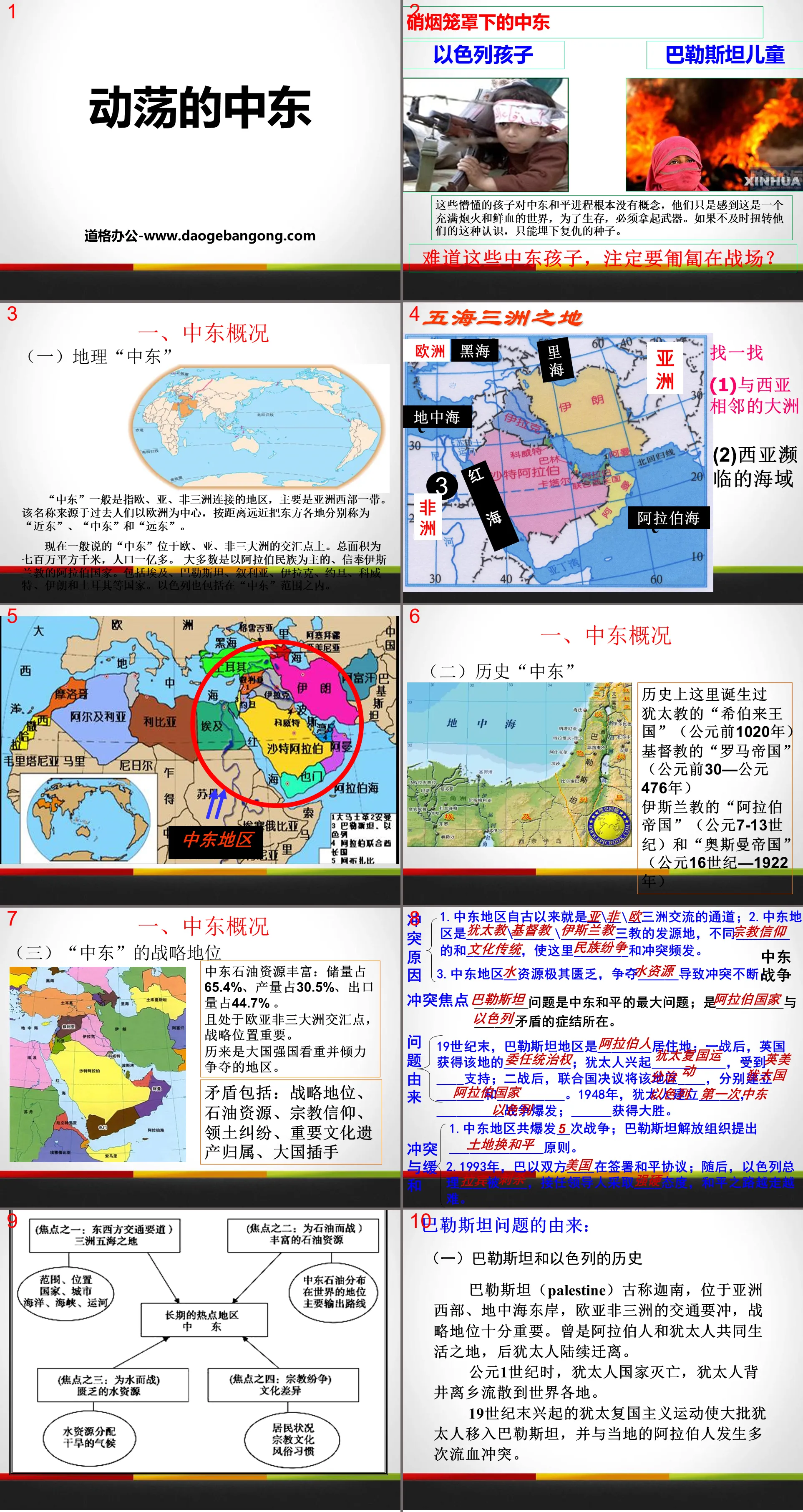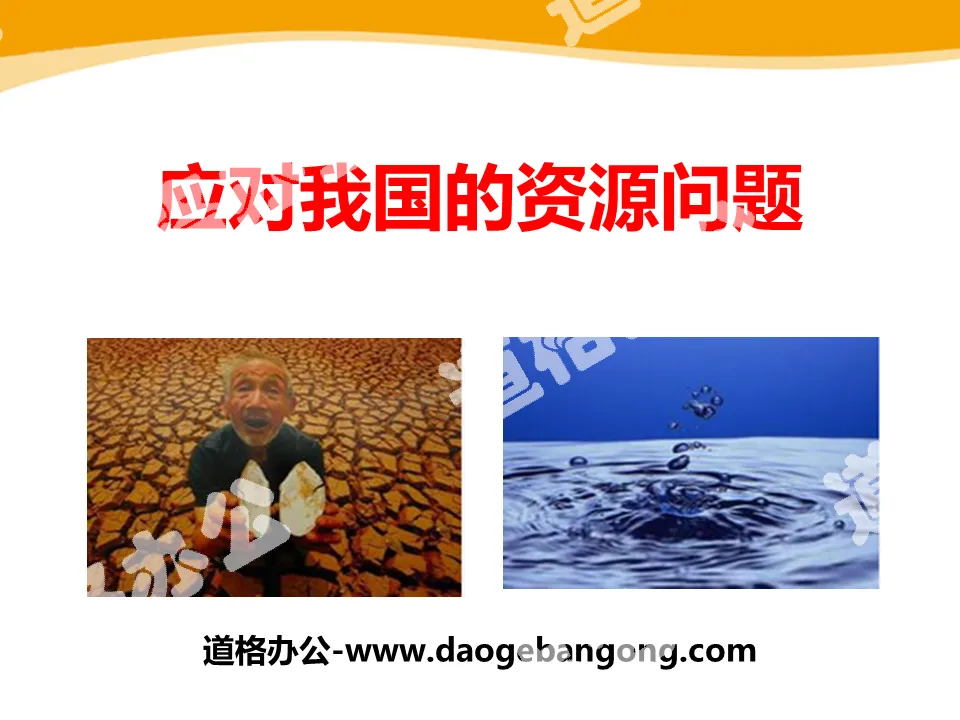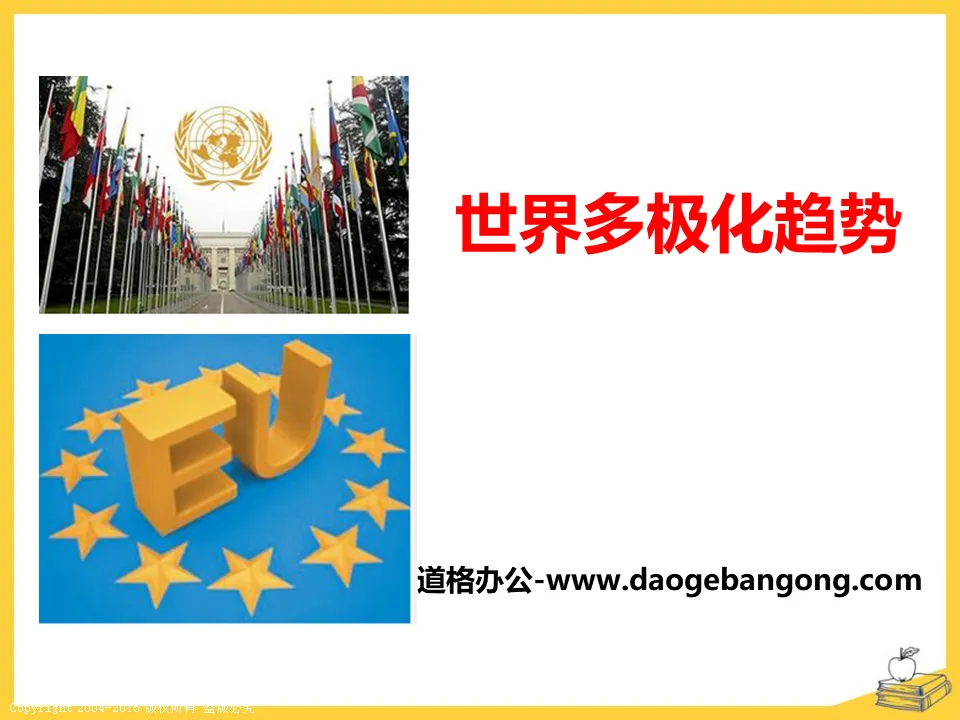
| Category | Format | Size |
|---|---|---|
| People's Education Edition History and Society 9th Grade Part II | pptx | 6 MB |
Description
"The Turbulent Middle East" The World During the Cold War PPT
Part One: Overview of the Middle East
(1) Geography "Middle East"
"Middle East" generally refers to the area connecting Europe, Asia, and Africa, mainly the western part of Asia. The name comes from the fact that in the past, people centered on Europe and called various parts of the East the "Near East", "Middle East" and "Far East" according to their distance.
The “Middle East” generally referred to today is located at the intersection of the three continents: Europe, Asia, and Africa. The total area is 7 million square kilometers and the population is over 100 million. Most of them are Arab countries that are predominantly Arab and believe in Islam. Including countries such as Egypt, Palestine, Syria, Iraq, Jordan, Kuwait, Iran and Turkey. Israel is also included in the “Middle East”.
(2) Historical "Middle East"
Historically, it was born here
The "Hebrew Kingdom" of Judaism (1020 BC)
The Christian “Roman Empire” (30 BC – 476 AD)
The Islamic "Arab Empire" (7th to 13th centuries AD) and the "Ottoman Empire" (16th century AD to 1922)
The Turbulent Middle East PPT, Part 2: The Origin of the Palestinian Issue:
(1) History of Palestine and Israel
Palestine, known as Canaan in ancient times, is located in the west of Asia and on the east coast of the Mediterranean. It is a transportation hub for Europe, Asia and Africa, and its strategic position is very important. It was once a place where Arabs and Jews lived together, but later the Jews moved away one after another.
In the 1st century AD, the Jewish state perished and the Jews fled their homes and dispersed around the world.
The Zionist movement that emerged at the end of the 19th century caused a large number of Jews to immigrate to Palestine, and led to many bloody conflicts with the local Arabs.
(2) Britain’s contradictory policies.
During World War I, in order to weaken the Ottoman Empire, the Arabs were promised a separate state whose territory could include Palestine.
After World War I, Palestine became a British "mandate". In 1917, British Foreign Secretary Balfour issued the "Balfour Declaration", expressing support for the restoration of Jewish state in Palestine.
(3) UN General Assembly Resolution 181.
The experience of the Jews being persecuted during World War II gained much sympathy from the world. In November 1947, the United Nations passed the resolution on the partition of Palestine, stipulating the establishment of a Jewish state and an Arab state in the Palestinian territories, and the internationalization of Jerusalem. The State of Israel was proclaimed in 1948, but the State of Palestine was not born.
The Turbulent Middle East PPT, Part Three: The Consequences of Five Middle East Wars:
1. Seriously hindered the social, economic and cultural development of the Middle East and brought serious disasters to the people;
2. Israel has occupied almost all of the Palestinian territory and part of the territory of other Arab countries, but has been unable to get its Arab neighbors to recognize its legal status in the Middle East;
3. Arab countries and Palestine cannot gain lost ground through war.
Understanding: War cannot resolve Arab-Israeli differences and grievances, and people of insight are constantly emerging to promote the Middle East peace process!
Turbulent Middle East PPT, Part 4: The tortuous road to peace in the Middle East
In September 1978, under the mediation of US President Carter, Sadat and Begin signed the Camp David Accords in the United States.
According to the agreement, Egypt regained the lost territory without firing a shot, resolved the territorial dispute between Egypt and Israel for more than 30 years, and set an example for other Arab countries to reconcile with Israel in the future.
In 1978, Sadat and Begin won the Nobel Peace Prize.
The conclusion of the peace agreement was criticized by all other Arab countries. Therefore, Sadat did not go to Oslo to receive the award, nor could he get rid of the bad luck of being assassinated on October 6, 1981 (to commemorate the 8th anniversary of the October War).
Turbulent Middle East PPT, Part 5: The future of the Middle East issue
Think about what ways can we continue to advance the Middle East peace process?
1. Solve the problem by peaceful means (land for peace) instead of using force to resolve the Palestinian-Israeli dispute;
2. Reasonably allocate water resources;
3. Respect the customs and habits of all ethnic groups and races:
4. Give full play to the role of the United Nations;
5. Oppose hegemonism and power politics;
6. Maintain peace and promote development.
Three stages of the Middle East peace "road map" plan
In the first phase (from the date of announcement in 2003 to May), Israel and Palestine will achieve a ceasefire; Palestine will combat terrorist activities and cooperate with Israel on security issues; Israel should withdraw after September 28, 2000 occupied Palestinian territory, froze the construction of settlements, and dismantled settlements established after March 2001.
The second phase (May 2003 to the end of 2003): The Israeli army withdraws from the occupied Palestinian territory to the greatest extent; Palestine promulgates its first constitution; establishes a Palestinian state with temporary borders; and promotes the recognition of the Palestinian state by the international community and the United Nations.
The third phase (from the end of 2003 to 2005): Negotiations on the final status of Palestine and Israel, including borders, status of Jerusalem, refugee rights of return, Jewish settlements, etc., and ultimately the establishment of a formal Palestinian state.
The Turbulent Middle East PPT, Part Six: Extracurricular Understanding
The special alliance between the United States and Israel
Material 1 The United States has emphasized its responsibility for Israel’s survival and security on many occasions, which is rare in contemporary international relations. For Israel, before it makes major foreign policies, it always needs the recognition and consent of the US government.
Material 2: The United States’ aid to Israel, including economic aid and military aid, exceeds that of any other recipient country. According to rough statistics, the total amount exceeded 40 billion US dollars.
Why has US-Israel relations developed to such an extent?
Information and data
Some Jews hold important positions in the U.S. federal and state governments. For example, former U.S. Secretary of State Kissinger, Attorney General Reeves, Chairman of the Federal Reserve Bank Burns, and Chairman of the Council of Economic Advisers Greenspan are all direct planners of U.S. policies. .
At the end of the 1970s, Jewish capitalists controlled 25% of the U.S. steel industry, 90% of the leather industry, 60% of the food processing industry, and 40% of the film and television entertainment industry.
28% of Americans who won the Nobel Prize are Jews; Jewish scientists who brought the United States into the nuclear age include Einstein, Taylor, and Newman; among experts in the U.S. aerospace industry, the highest proportion of Jews is 60%; 30% of the faculty are Jewish; the proportion of Jewish lawyers in the judicial department once reached 30%.
Reasons for the special relationship between the United States and Israel
Israel plays a pivotal role in the United States' Middle East strategy.
1. It can provide the United States with good military bases, strategic material reserves and transfer stations;
2. It has strong military power and can effectively safeguard U.S. interests in the Middle East;
3. Provided the United States with extremely valuable military experience and high-value intelligence;
4. Provide the United States with a "testing ground" for various new weapons.
Israel's political presence in the Middle East is in line with U.S. interests.
1. The political system, ideology and values are consistent.
2. The American public has sympathy and support.
Jews and pro-Israel forces in the United States often have the power to influence and even influence U.S. policy toward Israel.
Turbulent Middle East PPT, Part 7: Practice and Consolidation
1. Choice:
After World War II, which historical event directly triggered the first Middle East War? ( )
A. Britain and France invaded Egypt
B. The State of Israel was established in Palestine
C. Egypt and Syria attempt to regain lost territory
D. Israel launched surprise attacks on Arab countries
2. Historical Clinic
1. After World War I, Britain obtained the "mandatory power" over the Palestinian area. ( )
2. In 1949, the Jewish state of Israel was established. ( )
3. Four wars occurred between Arab countries and the State of Israel, known as the Middle East Wars in history. ( )
4. The geographical and strategic location of the Middle East is extremely important, but its oil resources are very poor. ( )
3. Short answer question: Where is the importance and complexity of the Middle East?
Answer: A. Importance: important transportation status; important strategic position; huge economic value.
B. Complexity: ① The interference of major powers in regional affairs has made territorial disputes serious; ② Complex ethnic conflicts, sharp religious struggles, etc.; ③ The shortage of water resources has intensified the competition between the two sides; ④ Decades of struggle have deepened the relationship between the two sides. hatred and fall into a vicious cycle of continuous revengeful behavior.
Keywords: free download of History and Society PPT courseware for the ninth grade of the People's Education Press, PPT download of the turbulent Middle East, PPT download of the world during the Cold War, .PPT format;
For more information about the PPT courseware "The World in the Cold War and the Turbulent Middle East", please click the "The World in the Cold War and the Turbulent Middle East" ppt tag.
"The Turbulent Middle East" The world during the Cold War PPT courseware:
"The Turbulent Middle East" The world during the Cold War PPT courseware Part One: The Palestinian issue The biggest issue affecting peace in the Middle East The fundamental crux of the conflict between Arab countries and Israel The origin of the Palestinian issue: ① The history of the Jews in the Palestinian area...
File Info
Update Time: 2024-07-12
This template belongs to History courseware People's Education Edition History and Society 9th Grade Part II industry PPT template
"The Turbulent Middle East" The World During the Cold War PPT Simple campus recruitment activity planning plan summary enterprise and institution recruitment publicity lecture PPT template is a general PPT template for business post competition provided by the manuscript PPT, simple campus recruitment activity planning plan summary enterprise and institution recruitment promotion Lecture PPT template, you can edit and modify the text and pictures in the source file by downloading the source file. If you want more exquisite business PPT templates, you can come to grid resource. Doug resource PPT, massive PPT template slide material download, we only make high-quality PPT templates!
Tips: If you open the template and feel that it is not suitable for all your needs, you can search for related content "The Turbulent Middle East" The World During the Cold War PPT is enough.
How to use the Windows system template
Directly decompress the file and use it with office or wps
How to use the Mac system template
Directly decompress the file and use it Office or wps can be used
Related reading
For more detailed PPT-related tutorials and font tutorials, you can view: Click to see
How to create a high-quality technological sense PPT? 4 ways to share the bottom of the box
Notice
Do not download in WeChat, Zhihu, QQ, built-in browsers, please use mobile browsers to download! If you are a mobile phone user, please download it on your computer!
1. The manuscript PPT is only for study and reference, please delete it 24 hours after downloading.
2. If the resource involves your legitimate rights and interests, delete it immediately.
3. Contact information: service@daogebangong.com
"The Turbulent Middle East" The World During the Cold War PPT, due to usage restrictions, it is only for personal study and reference use. For commercial use, please go to the relevant official website for authorization.
(Personal non-commercial use refers to the use of this font to complete the display of personal works, including but not limited to the design of personal papers, resumes, etc.)
Preview




















